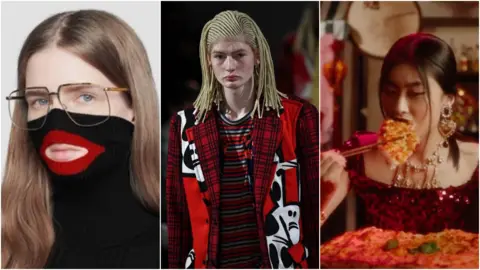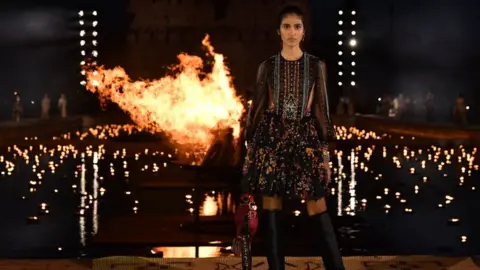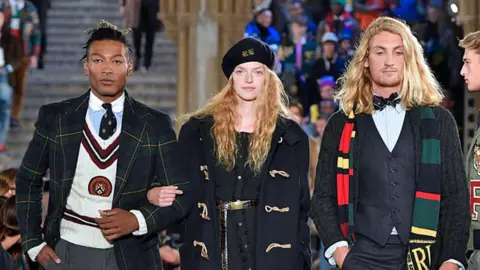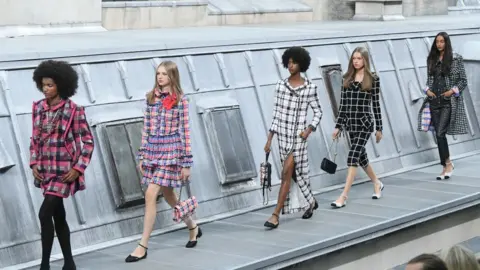What high fashion is doing about cultural appropriation
 Getty Images/ Gucci/ D&G
Getty Images/ Gucci/ D&GDolce & Gabbana trivialising Chinese culture in a campaign in 2018. Gucci pulling a jumper that resembles blackface in 2019. Commes Des Garçons using cornrow wigs on white models in 2020.
Just three examples of insensitivity and perceived cultural appropriation that have been criticised in high fashion over the last few years.
When Dolce & Gabbana faced backlash after posting videos of a Chinese model trying to eat pasta and pizza with chopsticks as part of its Shanghai campaign, its co-founder Domenico Dolce promised to do better.
Gucci said it would turn its blackface jumper incident last year "into a powerful learning moment for the Gucci team".
And while Comme Des Garçons' hair stylist Julien d'Ys has apologised and said it was "never my intention to hurt or offend anyone" after showing white models with cornrows, the incident is the latest talking point in the fashion industry.
'They did the research'
 ANNE-CHRISTINE POUJOULAT
ANNE-CHRISTINE POUJOULATThere are parallels between the Comme Des Garçons incident and one from 2015 - according to Lauren Indvik, fashion editor at the Financial Times - when a Valentino collection that was supposed to be a tribute to Africa featured predominantly white models and clothes made in Paris.
Maria Grazia Chiuri was the creative director of the fashion house at the time and received criticism for featuring fewer than ten black models in the show.
But the Italian designer, who is now in charge of Dior, has been perceived as making strides in representing cultures from around the world.
Her show in Marrakech was widely praised for its attention to detail - from employing an expert on African textiles to including benches with cushions embroidered by local weavers for guests to sit on.
Lauren says its success came down to following a model.
"They did the research and worked with local artists and curators - who gave a series of talks at the show - so people could really understand and educate themselves," she tells Radio 1 Newsbeat.
 Getty Images
Getty ImagesAccusations of cultural appropriation are nothing new - but the age of social media has created a lot more conversations about what's acceptable in fashion.
"There wasn't the same visibility and awareness and dialogue around cultural appropriation years ago, but the internet has made it so much more visible," Lauren says.
"But I think the industry has really woken up to this and there's been a real effort at being educated and appointing diversity councils.
"I think there's now a focus on recruiting for diversity that probably wasn't there three or four years ago."
 Getty Images
Getty ImagesShe cites Ralph Lauren as the best at implementing this model as the fashion house has "diversity and inclusion officers at every level of the organisation and within every team".
"You need to start by having a diversity council - brands like Chanel also have one and that's a really good step. You have to figure out what the problem is before you start solving it."
Since the criticism of its balaclava jumper Gucci has appointed a diversity officer, while Prada has set up an advisory panel co-chaired by director Ava DuVernay after coming under similar fire in recent years.
Lauren says if every company had a similar model and team approving decisions - from what materials are used for clothes to what language is used on social media - there would be fewer issues.
"Only when you have that perspective can you start to serve customers better and challenge the way you've been doing things forever," she adds.
 Getty Images
Getty ImagesIt's not just high fashion brands that have hit the wrong tone when it comes to respecting different cultures.
Last year Zara was criticised for drawing freckles on its Chinese models because Asian people typically do not have them and in 2018 H&M had to apologise after an advertising campaign showed a black child in a "coolest monkey in the jungle" hoodie.
"With fast fashion brands we're dealing with a lot more basic items - if you walk into Zara you're going to find lots of jeans, blazers and ankle boots.
"It's very different to runway collections - designers travel and get inspired and want to do collections around themes and tell stories so I don't think fast fashion is more diverse or better, they're just creating different kinds of products," Lauren says.


